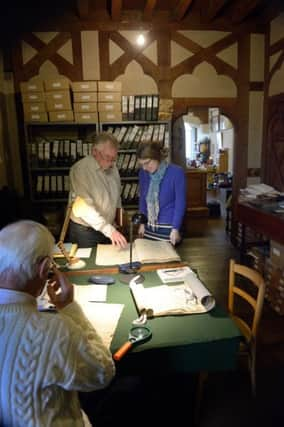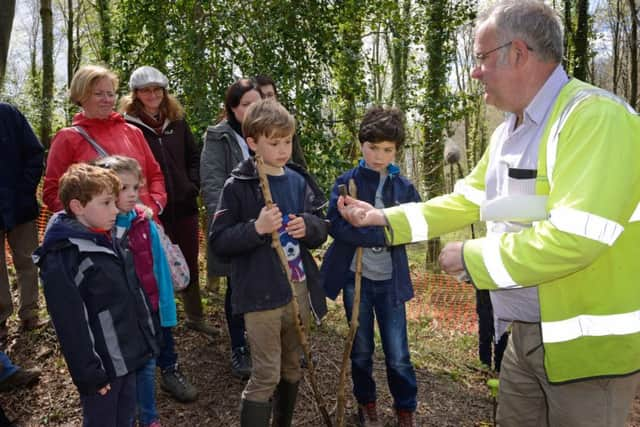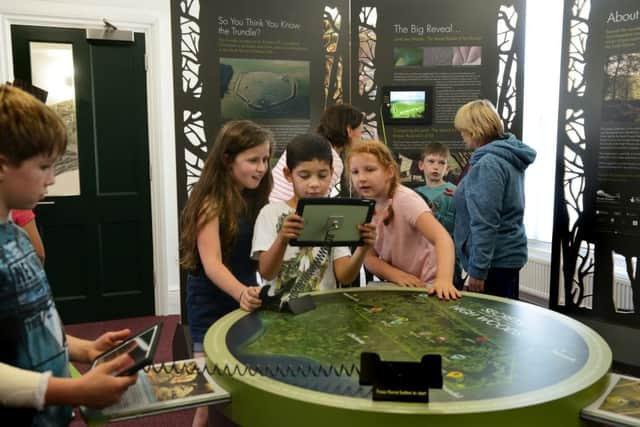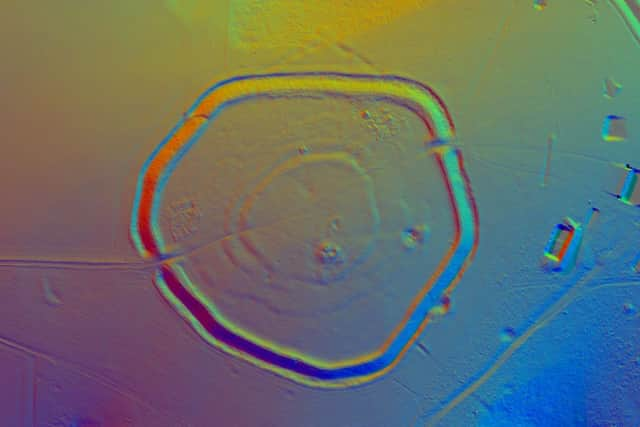Volunteers help unearth woodland's secrets


Secrets of the High Woods is a project run by the South Downs National Park Authority and supported by the Heritage Lottery Fund, and has so far revealed an extensive prehistoric field system and a missing Roman road. The discoveries were made after airborne laser scanning (LiDAR) technology were used to map part of the woodland area. LiDAR technology operates by lasers and light detection, measuring the distance from the plane to the ground and highlighting the lumps, bumps and hollows in the ground.
There are three strands to the project, all of which are supported by volunteers. Around 100 volunteers worked as groundtruthers, 17 volunteers collected oral histories from local people, and other volunteers worked as archival researchers, having been granted access to private documents to get information about the historic landscape.
Advertisement
Hide AdAdvertisement
Hide AdHenry Wakeford volunteered on the groundtruthing component of the project. He said: “What I find fascinating is seeing how the landscape has developed - from the Tudor trees which were cut down for the furnaces of the iron and glass industry, to the trees which were cleared during the First and Second World Wars, to seeing the trees which have been replanted over the last 70 years. This project is really important in terms of protecting what’s been discovered.”


Deborah Jordan is an oral history volunteer. She said: “This project has been so interesting, and doing the oral histories has been a humbling experience - people take you into their homes and talk about their personal recollections. One person I spoke to told me about their memories of the saw mills at Chilton and the area around the period of the Second World War. I was impressed with the sustainability of the workers at the saw mills, and think we can learn something about it today - even the wood chips were used to fuel the boilers.
“Men would talk about their jobs, but I thought it was interesting to hear the recollections of the women, who might not consider their memories special but I think are really interesting. One woman spoke about her memories of being a child in East Dean, where her family rented a house on the grounds of the Goodwood Estate. She spoke about her memories of going to the Christmas party which was held for the local children, and how delighted she was to have jelly! What also struck me was the drudgery - no sanitation and no running water. So many medical complaints were related to poor sanitation, and when the pipes went in, people started getting better. There were many bus routes from the more rural areas in Chichester - and people would lug their produce on the bus to sell it at Chichester market!
“My time on the project has been very stimulating, and the other volunteers have been very enthusiastic and knowledgeable. Although it’s been hard work, it’s encouraged me to pursue this interest.”
Advertisement
Hide AdAdvertisement
Hide AdAlthough supported by a wide group of volunteers, Secrets of the High Woods was also run by a team of historians and staff from the SDNPA.


Stephen Sibbald is the interpretation officer for the South Downs National Park Association. He said: “I’ve been involved in the Secrets of the High Woods project since its inception, and I’ve helped put together the exhibition. “For the exhibition, it was really important to build up the whole picture of the project and engage with the public. “We’ve tried to make it accessible for different audiences, and we think that the tablets enhance the story. “The LiDAR really underpins everything. “I hope people feel that they are part of the story, leaving traces behind, archaeology on top of archaeology - it’s been like peeling back the layers. “I hope people can reflect back on what they’ve learned here the next time they walk through the landscape, and they get a greater insight into their environment. “We developed a project app because we wanted people to be able to take some of the exhibition home with them, although that’s just one way of engaging with the project - we also are using social media. “This project is nationally significant - although it does pose more questions than it answers! For example, the CGIs in the outcome exhibition are as accurate as we can make them - but we don’t actually know if they would have paintings on the walls. It opens up further chapters for investigation. “The volunteers have been one of the real assets of the projects - they’ve even been requesting maps and other material so that they can steward the exhibition. “My background is design and ecology, and this is a project which reflects lots of different disciplines. The land has to be sensitively managed, both for its ecological and historical aspects, and as a project we had to work with the land managers to ensure this.”
James Kenny, archaeology officer at Chichester District Council, said: ”We’ve made some amazing individual discoveries, including hundreds of new burial mounds which date back to the Bronze Age, as well as the Roman Road from Chichester to Arundel, which probably ran from Chichester Harbour to the River Arun - there’s a Roman site under Arundel - and the road may have continued on to the ironworks in East Sussex. This means that the discoveries lead to further invesigation. “They are truly significant discoveries - we found a landscape of field systems. We didn’t expect to find that they’d be so encompassing. They are far more managed than anything we’d imagined.”
The project is supported by Historic England, the government funded agency to advise on heritage.
Advertisement
Hide AdAdvertisement
Hide AdAnne Bone, cultural heritage lead on the project, said: “We developed a software package so that we could work on the mapping with Heritage England in real time.” “This exhibition is an amazing end to a long project, and it’s absolutely crucial that we share the information we’ve found.” Fiona Small, aerial investigator at Historic England, said: “I have been working on identifying and mapping the find, using the photographs which were taken. “There were suspicions that there were the remains of a Roman road, has there had to be a route along the South of England. Through the work done on the landscape, we could see fragments of it, so we were able to confirm that speculation. “We had contact with the volunteers, feeding back and collaborating. It would be great to be able to inform people of what’s in their area, helping them to appreciate and understand their landscape.”


The project has produced a touring exhibition, which features iPads with computer programmes, and a virtual reality interactive experience.
The exhibition will be hosted at Fishbourne Roman Palace until August 15, after which it moves to Portsmouth City Museum to be shown August 20 and September 10. Petersfield Museum will host a smaller version of the exhibition August 16 and September 24. The main exhibition will continue at Worthing Museum October 4 to 26, and finally at Queen Elizabeth Country Park November 8 to 30. Find out more at southdowns.gov.uk/discover/heritage/secrets-of-the-high-woods.
Don’t miss out on all the latest breaking news where you live.
Advertisement
Hide AdAdvertisement
Hide AdHere are four ways you can be sure you’ll be amongst the first to know what’s going on.
1) Make our website your homepage
2) Like our Facebook page
3) Follow us on Twitter
4) Register with us by clicking on ‘sign in’ (top right corner). You can then receive our daily newsletter AND add your point of view to stories that you read here.
And do share with your family and friends - so they don’t miss out!
Always the first with your local news.
Be part of it.